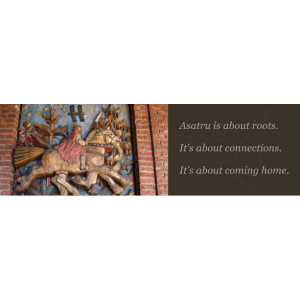 Key among the ritual structures developed by McNallen and Stine are the Sumbel (alternately spelled as symbel) and the Blot, drawn from Old Norse–Icelandic literary sources such as the Eddas and Sagas and other Germanic texts and traditions. The Sumbel is a drinking ritual, typically performed indoors, that may take place at any time or occasion agreed on by participants. In this ritual, as a drinking horn full of mead or other alcoholic beverage is passed and poured into individual drinking vessels or drunk from directly, a series of toasts are made, offering verbal tribute first to the Norse gods and supernatural beings, then to heroes and ancestors, and then to others. Oaths may also be made during a Sumbel, as well as “boasts,” or promises of future actions that participants intend to perform. Such oaths and boasts are considered solemn and binding on the speakers, which underlines the significance of the Sumbel as something much more than a mere drinking party. The words spoken in the Sumbel are considered consecrated and powerful and are visualized as entering the Well of Wyrd, the matrix of time and fate in Norse mythology, to become part of the individual and collective destiny of those assembled on the occasion.
Key among the ritual structures developed by McNallen and Stine are the Sumbel (alternately spelled as symbel) and the Blot, drawn from Old Norse–Icelandic literary sources such as the Eddas and Sagas and other Germanic texts and traditions. The Sumbel is a drinking ritual, typically performed indoors, that may take place at any time or occasion agreed on by participants. In this ritual, as a drinking horn full of mead or other alcoholic beverage is passed and poured into individual drinking vessels or drunk from directly, a series of toasts are made, offering verbal tribute first to the Norse gods and supernatural beings, then to heroes and ancestors, and then to others. Oaths may also be made during a Sumbel, as well as “boasts,” or promises of future actions that participants intend to perform. Such oaths and boasts are considered solemn and binding on the speakers, which underlines the significance of the Sumbel as something much more than a mere drinking party. The words spoken in the Sumbel are considered consecrated and powerful and are visualized as entering the Well of Wyrd, the matrix of time and fate in Norse mythology, to become part of the individual and collective destiny of those assembled on the occasion.
The Blot begins with invocations of the gods, similar to those pronounced in the Sumbel. Mead is once more involved, but whereas this is drunk from a horn passed around to the participants in the Sumbel, mead is contained in a sacred bowl in the Blot and not drunk but sprinkled onto the participants and onto altars and images of the gods by the priest or priestess, who performs this action with a sprig or branch of an evergreen tree dipped into the mead. At the conclusion of the rite, the mead is poured into the ground or into the fire as a final offering to the gods or ancestral spirits. A series of publications by McNallen (1986) offers suggestions about Blots for particular deities and occasions.
In past Nordic tradition, the Blot originally involved a ritual of animal sacrifice. Blood, the literal meaning of the word Blot, was caught from the slit throat of the slain animal in a sacred bowl and sprinkled onto participants and then poured or smeared onto images of the gods positioned on altars. Most modern Nordic Pagans have chosen to substitute mead for blood, while believing that they are preserving the same meaning of a distribution of life force between the participants and their gods. The ancient ritual would end with the participants feasting on the slain animal, cooked after its sacrifice. Modern Nordic Pagans likewise conclude their Blots with a feast.
Though the Sumbel and the Blot are the most well-known and widely shared forms of ritual in the overall Nordic Pagan community, there are others as well. These include Seid or Seith (Icelandic Sei?r), a Shamanistic practice involving trancelike, oracular states used for contacting gods and spirits (Blain 2002) and life cycle rites for births, comings of age, weddings, and funerals (McNallen 1986).
Free eBooks (Can Be Downloaded):
Aleister Crowley - The Soul Of The DesertAleister Crowley - The Zodiac And The Tarot
Pyotr Demianovich Ouspenskii - The Symbolism Of The Tarot